 Mike Smith* tells the tale of Arthur Smith Woodward – born 150 years ago this May - and the magnificent fossil fish collection he curated.
Mike Smith* tells the tale of Arthur Smith Woodward – born 150 years ago this May - and the magnificent fossil fish collection he curated.
The name Arthur Smith Woodward is most commonly linked with the East Sussex village of Piltdown. Sadly, his unwitting involvement in that hoax somewhat overshadows his achievements in vertebrate palaeontology - in particular, of fossil fishes. Arthur was just 18 when he started work at the Natural History Museum (NHM) in London, and soon settled down to a scientific career of hard work and dedication.
Left: Smith Woodward with his wife Maud, pictured in 1887.
PRECOCIOUS
Arthur had been a precocious student, already publishing a scientific paper before joining the Museum. He soon impressed all with his work ethic and intellect. He was fortunate in one important respect – the Museum’s extensive collection of fossil fish, particularly the recently-acquired Egerton and Enniskillen collections. The study of these and others was to lead to a comprehensive catalogue that, over 120 years later, remains an important reference. He described and figured approximately 300 new species of fossil fish. Today some of these same specimens are being re-examined using modern methods that are revealing detail of which Smith Woodward could hardly have dreamt.
Shortly after his parents vetoed a recommendation (from Professor William Boyd Dawkins) that Arthur apply for a vacancy at the Geological Survey of New South Wales (aged 17) Arthur’s father drew his attention to an advert in the Field (March 25, 1882) for a post at the British Museum.
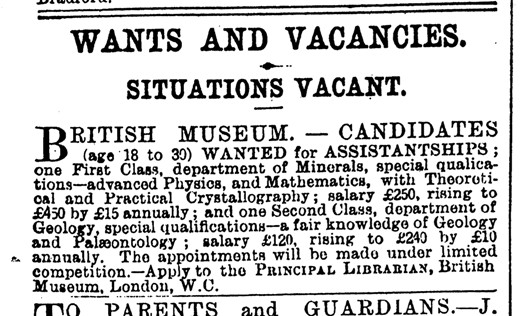 Right: The advert in Field to which Arthur responded.
Right: The advert in Field to which Arthur responded.
To apply for the position of Assistant, Second Class, the applicant had to have the permission of one of the three Principal Trustees of the British Museum – the Archbishop of Canterbury, the Lord Chancellor, or the Speaker of the House of Commons! With letters of introduction from local dignitaries in Macclesfield and Leek he was able to obtain the support of Sir Philip Cunliffe-Owen (Director of the South Kensington Museum) and eventually gain the support of the Archbishop of Canterbury.
Arthur joined the Geology Department on Thursday 24 August 1882. His first day did not go well. Keeper of Geology, Henry Woodward FRS FGS (no relation) rather resented the young man from Macclesfield. Firstly he had tried to appoint George C Crick FGS (1856-1917), who was working as a volunteer in his department but was told the position must be filled by examination. Arthur came first of the fourteen candidates sitting the Higher Civil Service Examination but Crick, nearly eight years Arthur’s senior, only managed fourth place.
Henry did not like having another ‘Woodward’ in his department. While initially suggesting Arthur adopt some other name, he decided Arthur should always use his full name, ‘Smith Woodward’ (Smith was his mother’s maiden name), to “avoid confusion”. Thus Arthur became known professionally as ‘Smith Woodward’. It was also made clear that he was on a year’s probation.
LONELY
Many years later in her memoirs1 Lady Woodward records that his first year in London was a very lonely one. Too young to join the Geological Society, he relied on invitations to meetings; but he had secured the job he most desired, and spent all his time working and studying.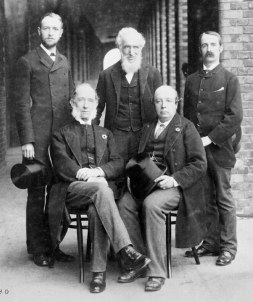
Left: NHM Geology Department Staff circa 1883. Back row (L-R) Arthur Smith Woodward, William Davies, R Bullen Newton. Front row (L-R) Robert Etheridge, Henry Woodward.
In August 1882 the new Museum building at South Kensington had been open for just 16 months and much of the exhibition space remained to be filled. Smith Woodward’s first tasks involved displaying and labelling the fossil vertebrates in the new galleries.
<Caption> Holocentrum melitense - a typical display of a fossil fish in an attractive mahogany surround.
But the main thrust of his future work and research was soon set. In 1882 and 1883 the Museum acquired the fossil fish collections of Sir Philip Malpas de Grey Egerton (1806-82) and William Willoughby Cole, 3rd Earl of Enniskillen (1807-1886). These two collections were undoubtedly the most important and comprehensive set of fossil fish ever assembled, many of them figured by Agassiz in his monumental work Recherches sur les Poissons Fossile (Geoscientist 23.01 February 2013) and containing many type specimens. In the summer of 1883 Smith Woodward attended the Swiney Lectures on fossil fishes given by Ramsey Heatley Traquair FRS, FGS (1840-1912) learning many new ideas on fish systematics.
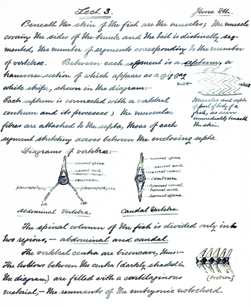 Right: A page from Smith Woodward’s Swiney Lectures notebook.
Right: A page from Smith Woodward’s Swiney Lectures notebook.
In his spare time Smith Woodward was studying for the London University BSc and continuing his researches on fossil fish. Between 1884 and 1886 he wrote a series of eight articles for Hardwicke’s Science-Gossip on Fossil Sharks and Rays that included 76 figures. He also published his first ichthyological scientific papers, also on sharks, in the Geological Magazine (edited by Henry Woodward. Smith Woodward was to be a prolific contributor).
It must have been clear to all that Smith Woodward was exceptionally talented. In 1886 Henry Woodward suggested that he consider writing “an exhaustive catalogue” of fossil fishes, to be published by the Museum. Realising what a huge task this would be, Smith Woodward chose to abandon his formal studies (for the second time) and devote himself to the research necessary to write the Catalogue of the Fossil Fishes in the British Museum (Natural History) – the ‘Catalogue’. This was to be a carefully researched series of books (published in four parts in1889, 1891, 1895 and 1901) that included numerous detailed descriptions of important specimens including many new to science. It included extensive references to all known fossil fish species, something he was only able to do by visiting all the important museums in the UK, Europe and the USA (largely self-funded).
MARRIAGE
Smith Woodward married Maud Leonora Ida Seeley, eldest daughter of Harry Govier Seeley FRS FGS (1839-1909) in June 1894. Seeley was Professor of Geography at University College, London at the time, becoming Professor of Geology and Mineralogy two years later. Maud accompanied her husband on many of his trips abroad and was quite happy to get her hands dirty, helping with excavations and fossil preparation. It was a life-long and happy marriage. They had a son, Cyril, and a daughter, Margaret. Tragically Cyril died while in the Borneo public service at the age of 24.
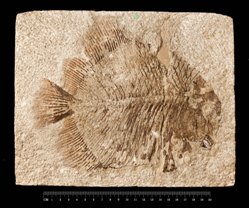 Left: Mesodon daviesi from the Purbeck Beds at Swanage, Dorset.
Left: Mesodon daviesi from the Purbeck Beds at Swanage, Dorset.
Smith Woodward had succeeded Robert Etheridge FRS FGS (1819-1903) as Assistant Keeper of Geology in 1892. On completion of the last part of the ‘Catalogue’ in 1901 and the retirement of Henry Woodward he became Keeper, a position he undoubtedly deserved given his scientific achievements and dedication. It must also have been very satisfying, having given up formal studies twice, to be awarded (in 1900) an honorary LLD from Glasgow University. Elevation to Keeper by no means marked the end of his scientific career - far from it. From 1901 until his retirement (1924) he published 64 papers or articles on fossil fish plus two monographs (The Fossil Fishes of the English Chalk and The Fossil Fishes of the English Wealden and Purbeck Formations) for the Palaeontographical Society. In the same period he also published 45 papers on other vertebrates and 20 on anthropology.
During his time at the Museum Smith Woodward described and named approximately 300 new species. All the fossil fishes featured in this article are Smith Woodward type specimens. The type specimen of Mesodon daviesi, a pycnodontid fish, was purchased by the Museum in 1869 and was named after the colleague who recognised it as belonging to genus Mesodon. The specimen’s counterpart was re-united with the type when the Museum purchased the Beckles Collection in 1891.
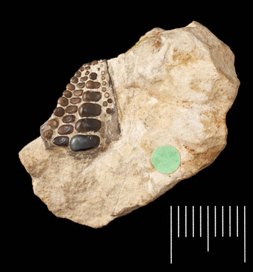 Right: Mesodon biserialis (Stonesfield Slate) acquired with the purchase of the Egerton Collection. The teeth are small, round or elongate, and used for crushing food such as crustaceans and molluscs.
Right: Mesodon biserialis (Stonesfield Slate) acquired with the purchase of the Egerton Collection. The teeth are small, round or elongate, and used for crushing food such as crustaceans and molluscs.
LEBANON
Several other collections of fossil fish obtained by the Museum rank in importance with the Egerton and Enniskillen collections, one being the Lewis collection (acquired 1875-95). Of the 11,500 or so registered specimens mentioned in the ‘Catalogue’, the top four collections in number are: Enniskillen (c. 2250), Egerton (c. 1884), Mantell (454) and Lewis (416). However, compared to the general nature of the Egerton and Enniskillen collections, the Lewis collection is composed entirely of Upper Cretaceous fossil fish from Lebanon. They were collected by the Rev. Professor E R Lewis of the Syrian Protestant College, Beirut. Apart from the fact that 30 of the specimens mentioned in the ‘Catalogue’, are type specimens, the Lewis collection contains some of the most beautifully preserved fossil fish, such as Aipichthys velifer .
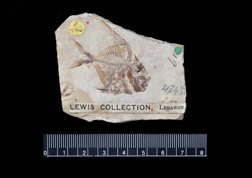 Left: Aipichthys velifer, a species described by Woodward in the ‘Catalogue’ Part IV. This specimen is from Hakel, about 60km from Beirut, which still produces important fossil fish.
Left: Aipichthys velifer, a species described by Woodward in the ‘Catalogue’ Part IV. This specimen is from Hakel, about 60km from Beirut, which still produces important fossil fish.
Fossil preparation techniques have come a long way since Smith Woodward’s time, such as the acid preparation method pioneered at the Museum by Harry Toombs (1909-87) in the 1930s and 40s, who used weak acetic acid on fossil fish preserved in chalk. Today the Museum uses one of the most effective (and non-destructive) investigative methods – X-ray computed tomography or CT scanning. The collection contains numerous chalk fossil fish preserved in full or partial 3D. CT scanning is currently being used to investigate fossils such as Sardinioides illustrans. With careful processing a wealth of detail can be revealed, leading to improved characterisation of species.
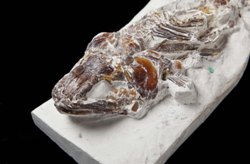 Pictures: Right: Sardinioides illustrans (right lateral view). This particular specimen is from the English Chalk and was acquired with the Enniskillen Collection. Left: CT Scan image of Sardinioides illustrans
Pictures: Right: Sardinioides illustrans (right lateral view). This particular specimen is from the English Chalk and was acquired with the Enniskillen Collection. Left: CT Scan image of Sardinioides illustrans
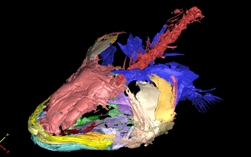 Peter Forey wrote in 2004: “The fossil fish collection at the Natural History Museum is, without a doubt, the finest such collection in the world (I make this claim with evidence and without shame)”. It is used almost daily by visiting scientists from around the globe. Arthur Smith Woodward certainly did much to make it what it is today, and he should certainly be remembered for that.
Peter Forey wrote in 2004: “The fossil fish collection at the Natural History Museum is, without a doubt, the finest such collection in the world (I make this claim with evidence and without shame)”. It is used almost daily by visiting scientists from around the globe. Arthur Smith Woodward certainly did much to make it what it is today, and he should certainly be remembered for that.
References
- Lady Smith Woodward’s Memoirs, The Natural History Museum Library Archive.
- Forey, P, The Spawning of the Fossil Fish Collection, Set in Stone, The NHM Palaeontology Dept. Newsletter, Autumn 2004. Vol. 2, No. 3.
Acknowledgements
Special thanks to Hermione Beckett of the Oxford University (CT scan). All other images © Natural History Museum.
* Dr Mike Smith is a consultant structural engineer employed principally in the offshore oil and gas industry. He also works as a volunteer at the NHM on the fossil fish collection.
- To find out more about this great British scientist why not come to the one-day symposium being held at the NHM in London on Wednesday 21 May, to celebrate his 150th birthday? Entrance is free to all but registration is required as numbers are limited. Go to www.nhm.ac.uk and type ‘Woodward 150’ in the search box for further details, or find it in Events on this website. The organisers gratefully acknowledge financial support from the Geological Society.